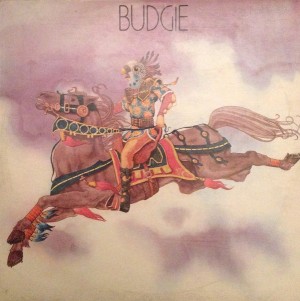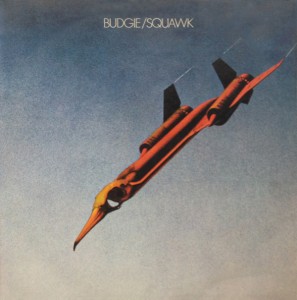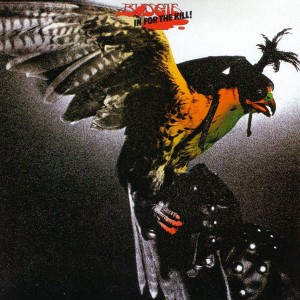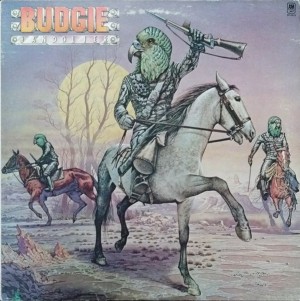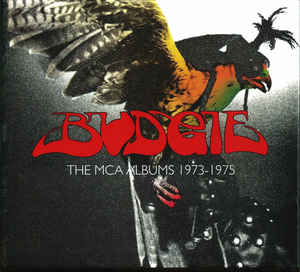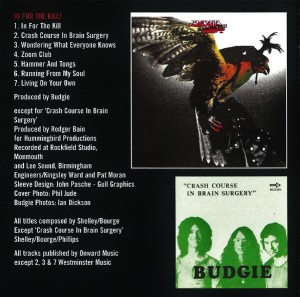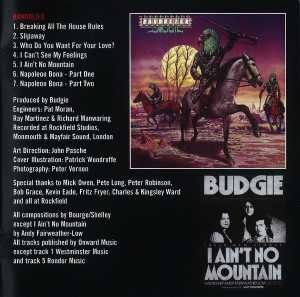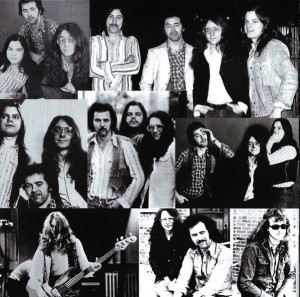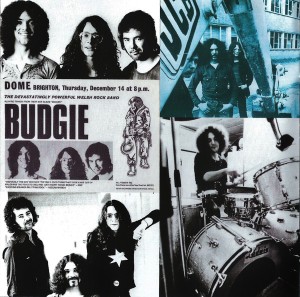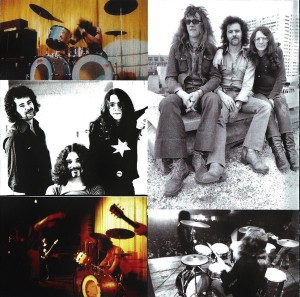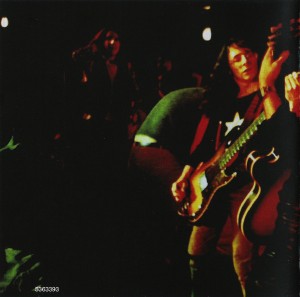BUDGIE-MCA ALBUMS 1973-1975.
BUDGIE-MCA ALBUMS 1973-1975.
By 1973, Budgie were one of the rising stars of British rock. The hard rocking Welsh trio had been formed in Cardiff in 1967. Originally, Budgie were known as Hills Contemporary Grass. However, after playing several gigs in 1968, Burke Shelley, Tony Bourge and Ray Phillips decided to changed the band’s name to Six Ton Budgie. Before long, this was shortened to Budgie. Little did anyone know that one of the most influential British heavy rock bands had just been christened.
Budgie would go on to influence a new generation rock bands. They became known as the new wave of British heavy metal. Bands like Judas Priest, Saxon, Iron Maiden, Raven and Def Leppard were among the bands that were inspired by Budgie’s music. This includes the three albums they recorded for MCA between 1973 and 1975.
The first of this trio of albums was Budgie’s third albums Never Turn Your Back On A Friend. It was released in 1973. In For The Kill followed in 1974 and Bandolier in 1975. These album feature in the MCA Albums 1973-1975 three album box set that was recently released by Universal Music Group. It’s the perfect introduction to Budgie, an oft-overlooked band. Their hard work and persistence began to pay off during the period the MCA Albums 1973-1975 box set covers. It had taken six years for Budgie to get to this stage.
Having changed their name to Budgie in 1968, the band began honing their sound by playing live. This was the tried and tested way that bands had honed their sound. There were no short cuts. Instead, it was just hard work and persistence.
Night after night, Budgie like many bands before them, pubs and clubs. Early on, Budgie played locally. Before long, Budgie began to play further afield. Gradually, Budgie began to attract a following. After nearly two years of playing live, decided to Budgie record their first demo.
Bassist and vocalist Burke Shelley, guitarist Tony Bourge and drummer Ray Phillips entered the studio and recorded what became their first demo in 1971. It was used to try and attract interest from record companies.
The first demo didn’t result in record companies rushing to Cardiff to sign Budgie. They were prepared to be patient, and play the long game. Eventually, Budgie’s patience paid off, and they were signed by MCA.
Budgie.
Once they had signed to MCA, the label began looking for the right producer for Budgie. Meanwhile, they were putting the finishing touches to the album they were writing. Eventually, Budgie were paired with Black Sabbath’s producer Roger Bain.
He had an enviable track record. Roger Bain had produced Black Sabbath’s first two albums. When Black Sabbath was released in February 1970, it was certified gold in the UK and platinum in America. Seven months later, Black Sabbath released Paranoid in September 1970. It was certified gold in the UK and four times platinum in America. Black Sabbath’s first two albums had sold five million copies in America along, and the man that produced the albums was about to work with Budgie.
For a band about to record their debut album, this was beyond their wildest dreams. Secretly, the three members of Budgie must have been dreaming that Roger Bain could do the same for Budgie.
They had finished writing the eight tracks that became debut album. Each of the tracks were credited to Burke Shelley, Tony Bourge and Ray Phillips. To record their debut album, Budgie were about to head to one of the prestigious studios, Rockfield Studios, in Monmouth, in Wales.
At Rockfield Studios, Budgie began recording the eight tracks with Roger Bain. Budgie decided to augment their core sound. Most things stayed the same though. Ray Phillips played drums and percussion and Tony Bourge guitar. Bassist and vocalist Burke Shelley played a mellotron on what became Budgie. It was completed during the first half of 1971.
The release of Budgie was scheduled for June 1971. Before that, the critics had their say. Mostly, the reviews of Budgie were positive. Alas, some critics weren’t convinced by Budgie. They were in a minority. Most were won over by heavy, hard rocking, blues rock sound and lightning fast, blistering guitar solos. Especially on Homicidal Suicidal and Nude Disintegrating Parachutist Woman, which were two of the highlights of Budgie, and why most of the reviews forecast that Budgie would be a success.
Upon the release of Budgie in 1971, the album failed to chart in the UK. Neither did the non=album single Crash Course In Brain Surgery. This was a huge disappointment for Budgie, Roger Bain and MCA. Later, like Metallica covered Crash Course In Brain Surgery.
Soundgarden and Thrush Hermit would all cover songs from Budgie. However, back in 1971, it was back to the drawing board for Budgie.
Squawk.
After the commercial failure of their eponymous debut album, Budgie returned to the live circuit. They were starting to build a following. Eventually, though, Budgie began work on their sophomore album.
Just like their debut album, the three members of Budgie wrote a total of nine tracks. They would later become Squawk. Just like Budgie, recording took place at Rockfield Studios with producer Roger Bain.
Work began at Rockfield Studios, Budgie during the first half of 1972. Drummer and percussionist Ray Phillips was joined in the rhythm section by bassist and vocalist Burke Shelley. He also played mellotron piano. Completing Budgie’s lineup, was guitarist Tony Bourge guitar. The album was recorded live. Budgie it seemed, were trying to capture the essence of one of their live performances. When the album was completed it became Squawk.
For Squawk’s album cover, MCA commissioned Roger Dean. By 1972, he was already regarded as one of the top album designers. He produced a truly memorable and thought provoking album cover. The first people to see it were the critics.
Just like Budgie, the majority of the reviews of Squawk were positive. There were still a few critics who were yet to be convinced. Mostly, Budgie’s hard rocking sound found favour with critics. Tracks like Rocking Man, The Beatles’ inspired Rolling Home Again, folk-tinged Make Me Happy and anthemic Drugstore Woman were among the highlights of Squawk. It was released in September 1972.
When Squawk was released, the album failed to much of an impression on the charts. This was another disappointment for Budgie. They returned to the live circuit and considered their options.
Never Turn Your Back On A Friend.
By the time Budgie thoughts turned to their third album, they had decided to make some changes. They quickly became apparent as work began on what would become Never Turn Your Back On A Friend.
For Never Turn Your Back On A Friend, Budgie penned six tracks. The other track was a cover version. This was a first. Usually, Budgie wrote their own material. However, Big Joe Williams’ Baby, Please Don’t Go was a blues classic. This was fitting for a group who had started life as a blues rock band.
Although Budgie were originally a blues rock band, their music was beginning to change on Never Turn Your Back On A Friend. Progressive rock was King in 1973, and Budgie moved towards progressive rock on Never Turn Your Back On A Friend. Still, though, Budgie were primarily a hard rocking band. They combined the hard rock and progressive rock on Never Turn Your Back On A Friend.
When recording begn at Rockfield Studios, there was no sign of Roger Bain. Budgie had decided to produce Never Turn Your Back On A Friend themselves. They had learnt from Roger Bain, and were ready to make their production debut on Never Turn Your Back On A Friend. It had a much leaner sound.
There was neither a piano nor mellotron on . Instead, it was just drummer Ray Phillips, bassist and vocalist Burke Shelley and guitarist Tony Bourge. They worked their way through seven tracks. where Budgie switched between blues rock, hard rock, progressive rock and proto-speed metal. These tracks eventually became Never Turn Your Back On A Friend.
Once Never Turn Your Back On A Friend was complete, MCA sent copies of the album to critics. They hailed the album Budgie’s finest yet. One of the highlights was Breadfan, which Metallica later covered. Parents a ten minute epic, is regarded as one the track that launched the speed metal genre. However, Never Turn Your Back On A Friend was the album that had most influence on the new wave of British heavy metal. It would inspire a new generation of bands. Despite doing so, Never Turn Your Back On A Friend wasn’t a huge commercial success.
Far from it. When Never Turn Your Back On A Friend was released in June 1973, the album failed to chart. That was Budgie’s third album that had failed to trouble the charts. For one member of Budgie, that was enough for him to call time on career with the band.
In late 1973, Ray Phillips left Budgie. He was replaced by Pete Boot. His timing was impeccable. Budgie’s fortunes were about to improve.
In For The Kill.
After the departure of Ray Phillips, a new chapter began in Budgie’s career. For the first few weeks, Burke Shelley and Tony Bourge gave the new recruit a crash course in Budgie’s back-catalogue. The new drummer, Pete Boot, had three albums to learn. Budgie were also in the process of working on their fourth album, In For The Kill.
Unlike Ray Phillips, Pete Boot took no part in writing In For The Kill. Instead, Burke Shelley and Tony Bourge wrote six of the seven songs on In For The Kill. The other track was Crash Course In Brain Surgery, which had been released as a single in 1971. It had been penned by the original lineup of Budgie, Ray Phillips, Burke Shelley and Tony Bourge. However, rather than use the original track, Budgie decided to remix the track.
There was a reason for this. This would allow the guitars to play a more prominent role in the track. It was a track used effectively and successfully by Black Sabbath’s Tony Iommi. If had been good enough for Black Sabbath, then it was good enough for Budgie. They began work on remixing Crash Course In Brain Surgery, and recording In For The Kill.
This took place at the familiar surroundings of Rockfield Studios in Monmouth. It was where Budgie’s three previous albums had been recorded. Three was about to become four, when the new lineup pressed play. The new lineup of drummer Pete Book, bassist and vocalist Burke Shelley and guitarist Tony Bourge worked their way though the seven songs. Just like Never Turn Your Back On A Friend, In For The Kill was produced by Budgie. Once the sessions at Rockfield Studios were complete, some further recording took place at Lee Sound, in Birmingham. Only then, was In For The Kill complete.
With In For The Kill complete, MCA scheduled the release of the album for May 1974. They wanted to build in the increasing popularity of Budgie. Their star was in the ascendancy. They had continued to increase their fan-base over the last few years. It had taken time, patience and persistence. Maybe In For The Kill would be a game-changer? That would depend on what the critics said.
Critics on hearing In For The Kill, hailed the album Budgie’s finest hour. However, they had said the same thing about Never Turn Your Back On A Friend. There were plenty of reasons to justify the critics conclusions.
This included In For The Kill, which featured a blistering guitar solo from Tony Bourge. Hot on its heels came the remixed version of Crash Course In Brain Surgery. With the power chords playing a prominent role in the track, it was regarded as one of the album’s highlights. So was the thoughtful Wondering What Everyone Knows, which seemed to have been inspired by The Beatles. Hammer and Tongs found Budgie at their hard rocking best, while Burke Shelley’s vocal adding an element of drama. Closing In For The Kill was the nine minute epic Living On Your Own. In For The Kill was indeed Budgie’s finest hour.
When it was released in May 1974, record buyers agreed. In For The Kill reached twenty-nine in the UK charts. After four albums, and seven years hard work and persistence, Budgie had made a breakthrough.
The sad thing was that the original drummer had Ray Phillips left Budgie just before the band made their breakthrough. His replacement Pete Boot was enjoying the fruits of his labours. He hadn’t spent six years crisscrossing Britain playing in pubs in clubs. However, Ray Phillips would later form his own band Ray Phillips Woman in the mid-seventies. By then, Budgie had lost their second drummer.
In late 1974, Budgie’s ‘new’ drummer Pete Boot left the band. This left Budgie in the lurch. Luckily, Steve Williams filled the void when Budge toured In For The Kill. Steve Williams later became a permanent member, and played on Budgie’s fifth album, Bandolier.
Bandolier.
Despite the success of In For The Kill, it was over a year before Budgie returned with the followup album, Bandolier. They had spent much of 1974 and part of 1975 touring. Budgie’s popularity was continuing to grow and this meant spending more time on the road. However, the time came to return to the recording studio.
By then, Burke Shelley and Tony Bourge had written five of the six songs on Bandolier. They were joined by a cover of Andy Fairweather Low’s Ain’t No Mountain. These six tracks were recorded at what had become Budgie’s studio of choice, Rockfield Studios.
Drummer Steve Williams, bassist and vocalist Burke Shelley and guitarist Tony Bourge began work on Bandolier at Rockfield Studios. Much of the album was recorded there. However, some recording took place at Mayfair Sound, in London. Eventually, Budgie had recorded six songs. They would become their fifth album, Bandolier.
With Bandolier completed, it was delivered to MCA. They scheduled the release of Bandolier for September 1975. This left plenty of time to promote Bandolier. Meanwhile, the critics had their say on the album.
They were won over by Bandolier, which found Budgie at their hard rocking best. Critics pointed out that Budgie were maturing and improving with each album. After five albums, Budgie had the potential to become one of the biggest British rock bands.
This was helped by Budgie’s new drummer Steve Williams quickly settling into his new role. He playing was powerful and punchy as he played with a newfound freedom. His drums helped propelled the arrangements along. Meanwhile, some critics were comparing Burke Shelley to Led Zeppelin frontman Robert Man. The similarity is noticeable on Who Do You Want For Your Love ?/Never Turn Your Back On A Friend and See My Feelings/Rock Climbing. As usual, Tony Bourge’s scorching, blistering, soaring guitar solos were playing a leading role in the sound and success of Bandolier. Especially on tracks like Breaking All The House Rules and I Can’t See My Feelings/Rock Climbing and I Ain’t No Mountain. Everything was coming together for Budgie on Bandolier.
They were still working hard and continued to reassess and reinvent their music. Constantly, they tweaked their sound adding or changing it. Over the past five albums, Budgie had moved from their early blues rock towards hard rock. Later, they incorporated folk, drew inspiration from The Beatles and moved in the direction of progressive rock. However, for much of the time, Budgie were an inventive, hard rocking band that always featured talented musicians. Proof of this was their four previous albums, and their fifth album Bandolier.
When Bandolier was released in September 1975, the album reached thirty-six in the UK. Alas, Bandolier hadn’t quite matched the success of In For The Kill. It had reached twenty-nine in 1974. However, Bandolier was certified gold. This was a first for Budgie.
A gold disc was the perfect way for Budgie to end their time at MCA. After five albums, where Budgie’s sound continued to evolve, the inventive Welsh trio’s popularity blossomed. By the time Bandolier was released in 1975, they had reached new levels of popularity. It was ironic that Budgie were about to leave MCA and sign for A&M Records.
The five albums that Budgie had recorded for MCA featured some of the best, and most successful of Budgie’s career. This includes Never Turn Your Back On A Friend, In For The Kill and Bandolier. They feature on the recently released MCA Albums 1973-1975 three album box set that was recently released by Universal Music Group. It’s the perfect introduction to Budgie, who are an oft-overlooked band. Their hard work and persistence began to pay off during the period.
In For The Kill reached twenty-nine in the UK and Bandolier thirty-six. That looked like it was the start of the rise and rise of Budgie. Many critics thought that within a year or two, Budgie would be rubbing shoulders with Black Sabbath and Led Zeppelin. Sadly, Budgie never built on the success of
However, they never built on the success of In For The Kill and Bandolier. Budgie’s next three albums, 1976s If I Were Brittania I’d Waive the Rule, 1978s Impeckable and 1980s Power Supply all failed to chart. By then, the only original member was Burke Shelley.
In 1981, Budgie’s Nightflight ninth album reached number sixty-eight in the UK charts. A year later, Deliver Us From Evil reached sixty-two in the UK. Six years later, Budgie disbanded and didn’t release another album for twenty-four years.
Budgie returned in 2006 with You’re All Living In Cuckooland. Only Burke Shelley and Steve Williams remained from the previous incarnation of Budgie. Despite touring You’re All Living In Cuckooland., it failed to chart. For Budgie, their eleventh album was their swan-song.
For anyone yet to discover Budgie’s music, then MCA Albums 1973-1975 is a good place to start. It’s just a pity that their first two album, Budgie and Squawk were included and this would’ve featured everything that Budgie recorded for MCA. However, MCA Albums 1973-1975 is a reminder of one of the hardest rocking bands of the early seventies, Budgie who could’ve and should’ve gone on to become one of biggest names in British rock.
BUDGIE-MCA ALBUMS 1973-1975.
